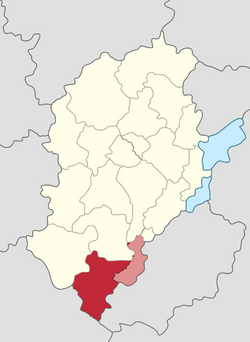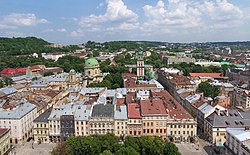Małomiersa
Małomiersan voivodeship
Województwo małomierskie (Miersan) | |
|---|---|
 | |
| Country | |
| Established | 3 October, 1936 |
| Capital | Sechia |
| Government | |
| • Voivode | Teofil Zarzecki |
| Area | |
| • Total | 30,168.32 km2 (11,648.05 sq mi) |
| Population (2017) | |
| • Total | 1,487,711 |
| • Rank | 6th in West Miersa |
| • Density | 49.31/km2 (127.7/sq mi) |
| Time zone | UTC-1 (Miersan Standard Time) |
| • Summer (DST) | UTC0 (Miersan Summer Time) |
Małomiersa is a voivodeship located in the Miersan Sotirian Republic. As the southernmost voivodeship of the Miersan Sotirian Republic, it is bordered to the west by Minrovina, to the south by Slirnia, and to the southeast by the breakaway State of Lemovicia, which is claimed by West Miersa to be part of the voivodeship of Małomiersa.
Historically home to a Lemovician community, since the Lemovician War, Małomiersa has become homogenized since the Lemovician War, due to ethnic cleansing perpetrated by the Miersan National Armed Forces, and now is overwhelmingly Miersan.
Etymology
The name Małomiersa means "little Miersa" in Miersan, first appearing after the partition of the Lemovician Lordship between the Miersan Commonwealth and the Trio Unium Nationium. The term was adopted to describe what had been the northern areas of the lordship (as opposed to the southern part, which would become known as Illirska), both due to its size, and because of a desire by the then King TBD to "make the land an integral part of the Miersan nation," particularly due to its natural defences.
History
Establishment

Despite efforts by Lemovicians to remain part of Soravia, as the region of Małomiersa had been "thoroughly integrated" with the Miersan Governate, combined with assurances that Soravia would continue to have influence over West Miersa, it was decided that Małomiersa was to become part of the newly-established Miersan Sotirian Republic, as the Małomiersan voivodeship, with its capital to be in the city of Mistózburó (present-day Topagunea). That year, the share of ethnic Lemovicians was at 46% of the voivodeship's population, while Miersans only formed 42% of the population.
Thus, when the Miersan Sotirian Republic came into existence on 3 October, 1936, the voivodeship was officially established. From the beginning, the Lemovician community were subject to a policy of Miersanization, with the Lemovician language being prohibited from being used in schools and in governmental jobs. As well, due to the region's significant coal and iron deposits, mining towns were established in the Mendija Mountains, bringing with them many ethnic Miersans.
Under Iwon Wojdyla's presidency from 1956 to 1961, he allowed the recognition of minority languages, with the national government declaring Lemovician to be a minority language. However, the Miersanization policy was resumed by his successor, Romuald Wojdyla, with Lemovician no longer recongised as a minority language in 1962.
In the 1970s, as the coal and iron mines began closing down in the region, tensions between Miersans and Lemovicians grew, due to growing unemployment, and the discrimination against Lemovicians. By 1977, Lemovicians only formed 34% of the voivodial population, while Miersans formed 63% of the population.
Lemovician War

With the outbreak of the Miersan War in 1979, the Lemovician community proclaimed their independence as the State of Lemovicia, which quickly aligned itself with East Miersa, in reaction to West Miersa's continued discriminatory treatment. During the Miersan War, virtually all of Lemovicia was under separatist control, but upon the signing of the Treaty of San Alessandro, East Miersan support became largely indirect, allowing for Miersans residing in the voivodeship to rebel against the Lemovician community, and restore West Miersan control over Małomiersa.
With the assistance of the Miersan National Armed Forces, and renewed Soravian support, by 1983, the separatists lost control of the northwestern regions. Ethnic cleansing against Lemovicians was rampant, leading to Lemovicians fleeing for separatist-controlled territory. By 1988, Sechia and the powiat of Dolina which were still under Lemovician control finally fell to the West Miersan forces, resulting in Lemovicians in these areas fleeing to Lemovician-controlled territory or to foreign countries.
A stalemate gradually developed, forcing the Lemovician War to end in 1992 with the signing of the CN-backed Arciluco Agreement, which although did not lead to either side renouncing claims, did end the war. As most of Mistózburó was still under the control of the separatists, the voivodial capital was relocated to Sechia, due to the infrastructure present there, and due to security concerns. By this point, most Miersans in Lemovicia had ended up in West Miersa, mostly in the areas of the Małomiersan voivodeship under West Miersan control, while Lemovicians in the Małomiersan voivodeship had fled to Lemovicia.
Contemporary era

Since the end of the Lemovician War in 1992, the Małomiersan voivodeship began rebuilding. Unlike Lemovicia, the relative lack of sanctions enabled Małomiersa to quickly rebuild and recover, particularly in Sechia, due to its position as both one of the largest cities in the Miersan Sotirian Republic and the capital of the voivodeship.
By the 2000s, most of the war damage had been repaired, and Małomiersa had a higher gross domestic product per capita than Lemovicia. During this period, Małomiersa was further connected with the rest of West Miersa, such as improved motorways from Sechia to Krada. However, the 2005 recession affected Małomiersa harder than the neighbouring Lemovicia, and even harder than in Krada, as many companies based in Małomiersa went out of buisness, and foreign investment in the area ground to a halt. The voivodial economy would only reach its pre-2005 status in 2011, only for the 2013 constitutional crisis to induce economic uncertainty.
However, Małomiersa continues to be plagued with many social problems, such as the continued discrimination against Lemovicians by Miersans and by the West Miersan government, as well as corruption, and a substantial presence of organized crime in the region.
Government
Prior to the passage of the third amendment to the West Miersan constitution, the Małomiersan government had nominal authority over education, healthcare, welfare, powiats and municipalities. The voivode was elected by West Miersan citizens residing in the voivodeship, using first-past-the-post.
However, since the passage of the third amendment in October 2020, the voivodeship's authority was significantly curtailed, with the voivode to be appointed by the President, and the powers of the voivodial assembly restricted to powers delegated by the Miersan government.
The 58-seat Voivodial Assembly is elected by West Miersan citizens residing in the voivodeship, using first-past-the-post, and is based in Sechia. Małomiersa is divided into seven powiaty, corresponding to the traditional Lemovician provinces.
Demographics
As of the 2017 census, there were 1,487,711 inhabitants in the voivodeship of Małomiersa, making it the sixth most populous voivodeship under the jurisdiction of the Miersan Sotirian Republic.
Ethnically, the largest ethnic group are the Miersans, who comprise 83.5% of the population, or 1,242,892 people. The next largest group are the Lemovicians, making up 7.2% of the population, or 107,611 people, followed closely by Radushians at 6.7% of the population, or 99,472 people. Savaders make up 1.3% of the population, or 19,533 people, with all other ethnicities making up 1.3% of the population, or 18,203 people.
Religiously, the largest sect is the Miersan Episemialist Church, followed by 871,594 people, or 58.5% of the population. The next largest religious sect are the Catholics, making up 38.7% of the population, or 575,593 people. Of the remainder of the population, 29,751 follow other religions, mostly Marolevic neopaganism, and 10,773 people are irreligious.
Linguistically, the most spoken language is Miersan, spoken by 1,426,021 people, or 95.8% of the population. This is followed by Lemovician, which is only spoken by 41,841 people, or 2.9% of the population. 13,022 speak Savader as a first language, or about 0.8% of the population, while other languages are spoken by 6,827 people, or only about 0.5% of the population.
